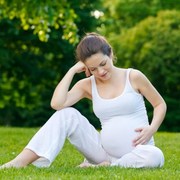 Photo: Getty Images
Photo: Getty Images
When a mom-to-be finds out she is expecting a baby, she is understandably excited and scared all at the same time. All of a sudden there are rules for eating, drinking, and activities.
She now has to think about another tiny human being and how her actions will affect the baby. But what can moms-to-be do?
Is tennis off-limits? What about ice skating? Running? Should pregnant moms even be exercising at all? Read on.
In the August/September issue of Fit Pregnancy magazine, writer Suzanne Schlosberg, dispelled the myth that pregnant women shouldn’t exercise. She wrote that even if the mom-to-be wasn't a regular at the gym before she was pregnant, now is a terrific time to start.
The bigger hazard is inactivity because it can lead to excessive weight gain, high blood pressure, greater risk for gestational diabetes and cesarean sections.
Exercise, even very moderate exercise, can help with pregnancy aches and pains and even help alleviate morning sickness. The Fit Pregnancy article recommended 30 to 60 minutes of moderate walking.
Ms. Schlosberg went on to write, “early in pregnancy, elevating your core body temperature may be damaging to the fetus, so stay hydrated, don’t exercise outdoors in the heat of the day and avoid huffing and puffing so hard that you can’t talk.”
Babycenter.com recommended that pregnant women avoid contact sports or ones that might keep them off balance like ice skating, horseback riding, or biking.
The higher hormone levels of relaxin relaxes the pelvic muscles to help get them ready for child birth, but that hormone also loosens all joints throughout the body and can cause sprains and other injuries as well.
Extra relaxin can also make moms-to-be a little less graceful and more susceptible to falls. Obviously, falling when pregnant can cause extreme harm to the baby and should be avoided at all costs.
Babycenter.com also warned pregnant moms not to lie flat on their backs when working out, not to overdo it, and to make sure to stay hydrated during an exercise session.
The bottom line is that exercising when pregnant offers great benefits for both the mom and baby, but moms-to-be need to be aware of what they are doing and how they are doing it so as not to injure themselves or their unborn baby.
Sources:
Fit Pregnancy. August/September issue. "Truth about Prenatal Exercise." http://www.fitpregnancy.com/workouts/prenatal-workouts/truth-about-prenatal-exercise
Babycenter.com. Vicki Lee Edge, M.D., August 2006. Web. "The 13 ruls of safe pregnancy exercise."
http://www.babycenter.com/0_the-13-rules-of-safe-pregnancy-exercise_622.bc
Reviewed November 3, 2011
by Michele Blacksberg RN
Edited by Jody Smith





Add a Comment3 Comments
Great information!!! Thanks for sharing.
November 7, 2011 - 11:38amThis Comment
All pregnant women should strengthen their deepest abdominal muscle, their Transverse Abdominis, or TvA, to prevent common pregnancy related complaints and complications such as diastasis recti (abdominal separation), back pain, and pelvic instability. As an added benefit, because the TvA is the primary expulsion muscle, maintaining strength in this muscle greatly aids in the pushing phase of labor.
November 4, 2011 - 10:58amThis Comment
Very Important for moms to know. Great to be fit, but always use caution and don't do the extreme.
November 3, 2011 - 5:10pmThis Comment